GitOps is an emerging principle that streamlines infrastructure and application development lifecycle management.
Today, many companies are adopting GitOps to build software development pipelines, manage configurations, code applications, provision the Kubernetes clusters, and deploy configurations.
Generally, GitOps is a subset of DevOps and combines a tool (Git) and System Operations (Ops) to automate the infrastructure and improve delivery speeds. It shares the same goal as DevOps but uses a different approach.
The GitOps methodology includes various tools and practices. Typical tools include Git repositories, Kubernetes, configuration management, and CI/CD tools. Even though GitOps is used mainly on Kubernetes, it can support other infrastructure and deployment platforms.
This article will discuss what GitOps is, how it supports DevOps and its benefits. We will then look at some of the potential GitOps tools in the market.
What is GitOps?
GitOps is an operational framework that applies DevOps practices to improve infrastructure automation and application development. It includes a tool (Git) and system Operations (Ops) to apply DevOps practices in managing applications and infrastructure.
The GitOps principles allow DevOps teams to automate and streamline the configuration, deployment, version control, monitoring, and management of software development and deployment lifecycle, ensuring reliability, security, and consistency.
The framework uses the Git repositories as a single source of truth when delivering infrastructure as code. It tracks all the changes in the code in the repository. And this makes it easy to update the systems, provide version control and roll back.
Other benefits include a reduced number of variables to manage the infrastructure, better visibility into the changes, and a smaller attack surface.
GitOps supports DevOps by improving automation and making it easier to quickly reverse changes. The two methodologies work together to improve the overall software development and deployment lifecycle.
In practice, DevOps is a pipeline process that is used by developers and operations teams. On the other hand, GitOps is a development mechanism that is used by developers.
Whereas DevOps focuses on operational aspects, GitOps focuses on automating and tracking the changes in the development environment.
GitOps Principles
GitOps utilizes the Git repositories to store code and declarative specifications for the resources and environment to run the code. It reduces the risk of drifts, inconsistencies, human errors, and manual interventions.
Following are some of the main GitOps principles.
- Declarative infrastructure
- Version control
- Software agents
- Automated change approvals.
Benefits of GitOps Principles
GitOps provides benefits such as standard workflow, improved security, reliability, visibility, consistency, and version control.
- GitOps enables teams to easily trace and audit all the changes made throughout the application life cycle in the Git repository.
- Improved developer experience and productivity result in faster, more reliable, and frequent delivery of changes.
- Better collaboration and visibility.
- Transparency on code changes, including developers who made the change, reason, and impact.
- Reduces risks of errors by using automated agents, such as the Kubernetes operator, to enforce the desired state of systems and services.
- Enhances consistency, compliance, and security.
GitOps Workflow

A GitOps workflow outlines the process of implementing software changes and deployments. A typical workflow follows the following steps.
- A software developer writes the code.
- The developer commits it to the version control system.
- Code is automatically tested by the Continuous Integration server.
- If there are errors or bugs, the build fails, and the server notifies the developer.
- However, if the code passes the test, the server approves it and pushes it to the container image repository automatically.
- After pushing the code to the repository, an automated deployment tool detects the change. The tool pulls changes from the registry and then updates the YAML file in the configuration repository.
- Finally, the GitOps agent will detect the change in the cluster. In return, it pulls the change from the configuration repository and updates the cluster accordingly.
As the GitOps principles evolve, here are some of the most promising tools.
Flux

Flux is a group of flexible and progressive delivery tools for open and extensible Kubernetes projects. It empowers teams to use GitOps to manage the deployment of applications and the infrastructure. It provides a simple interface for setting up a GitOps workflow.
Key Features
- Provides automated deployment of code changes to Kubernetes.
- Works with popular products and tools such as GitHub, GitLab, webhooks, Helm, Kustomize, chat systems such as Slack, Kubernetes RBAC, and more.
- It supports multi-cluster environments and can delete unused resources in a cluster.
- It enables you to audit transactions via the Git history, hence an opportunity to roll back to a stable version and recover state in case of a failure.
- Works with other popular tools, container industries, and Git providers such as BitBucket, GitHub, and GitLab. Additionally, it integrates well with Open Container Initiative (OCI) and Continuous Integration (CI) workflow providers.
Also read: Getting Started with Kubernetes: An Introduction for Beginners
GitLab for GitOps
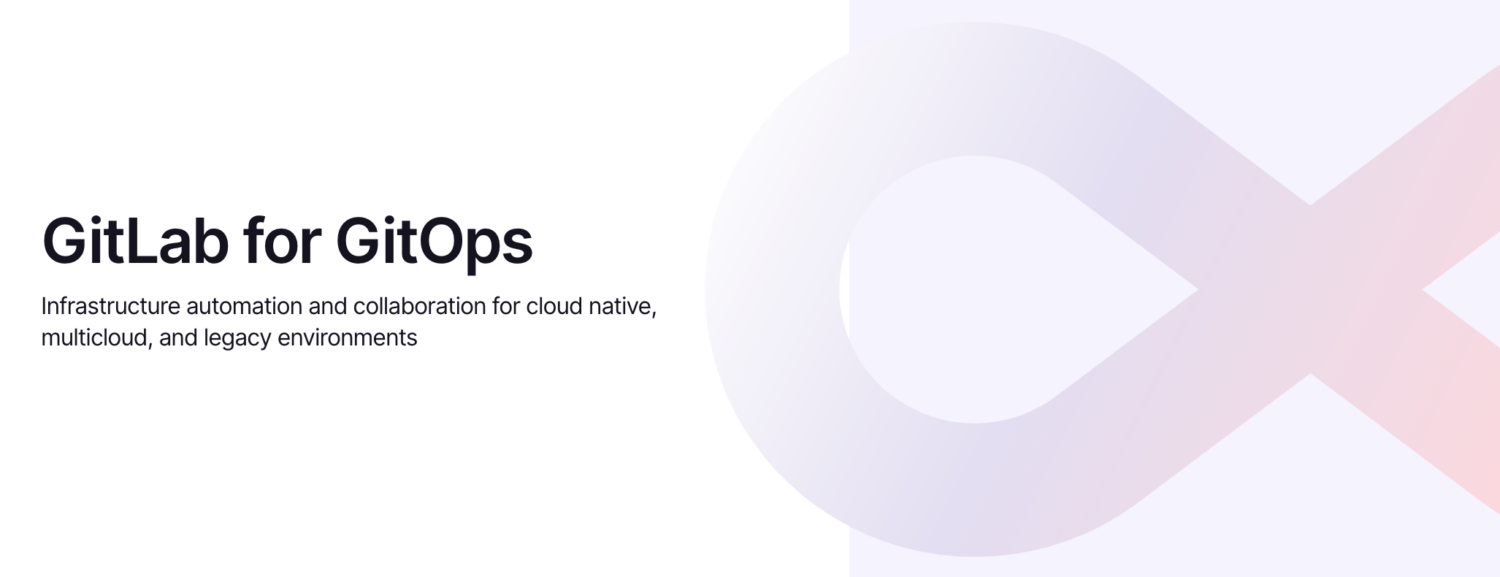
GitLabs for GitOps is a powerful platform that supports infrastructure automation for legacy, multi-cloud and cloud-native environments.
Key Features
- Provides version control, security, stability, and reliability of the application development environment.
- You can use the tool in a single application mode to support all your source code management and CI/CD needs. This includes planning, version control, deploying code, and more.
- It is integrated with Terraform to provide reliable environment provisioning.
- Provides enhanced code review to detect errors and improve quality.
- It enables you to deploy anywhere, including containers, virtual machines, multi-cloud environments, AWS, Google Cloud, Microsoft Azure, and more.
It also enables organizations to improve collaboration between development, operations, and infrastructure teams.
Codefresh

Codefresh is an easy-to-use platform with many features built on GitOps for reliable management and traceability. It enables you to define reusable custom steps which you can use for several pipelines.
Key Features
- Improve your build pipelines using advanced parallelization, enhanced caching, and flexible triggers.
- The platform uses advanced multi-layer algorithms and parallel tests to improve the time it takes to build and test software, reducing and enabling the developers to get timely feedback and take action accordingly.
- It enables you to build, test and deploy software flexibly, scalable, and faster.
- Highly scalable with the ability to handle large and complex projects. Easy to integrate with popular tools such as Kubernetes, GitHub, Docker, and more
- Provides an easy-to-use platform that automates the building, testing, and deploying of software products and features.
The solution has highly extensible and flexible features to meet current and future needs in on-premise and cloud environments.
Argo CD

Argo CD is a powerful declarative Continuous Delivery solution that automatically synchronizes and deploys software applications when developers change their GitHub Repository.
Key Features
- Easy-to-understand user interface for organizing and managing complex data.
- Ability to manage various manifests for Kubernetes, including customized applications, YAML files, JSON files, Jsonnet, Helm charts, and more.
- Works as a Kubernetes extension to offer real-time updates of the application state as well as visibility into the cluster.
- It enables teams to check the git repository, gain visibility, and discover what is running in a cluster.
- Lightweight and highly secure tool since it pulls the changes from the Git Repo, hence a smaller attack surface.
It helps to manage the deployment lifecycle in Kubernetes environments. Consequently, this provides configurations, version control, and application definition services.
Weave GitOps
Weave GitOps is a continuous operation tool that helps teams to simplify the deployment and management of Kubernetes clusters and software applications.
Key Features
- The powerful tool supports any environment and scaling needs hence making it easy to use GitOps to adopt and scale continuous delivery.
- Integrates with existing security controls such as single sign-on (SSO) to enhance security and support role-based access control (RBAC).
- It provides visibility and allows teams to view issues and reconciliation in real time. And this makes it easier and faster to identify and address problems.
- Use GitOps to manage Terraform functions such as automation, reconciliation, drift detection, and other services.
- Integrating GitOps with your application and infrastructure resources enables you to easily add more capabilities.
It is an extension of Flux that provides useful insights into the software application deployment pipeline.
Carvel

Carvel is a set of open source single-purpose composable tools to help you build, configure and deploy applications to Kubernetes.
Key Features
- You can use the GitOps tool to install, upgrade, and delete several Kubernetes resources.
- Securely and reliably generate passwords, certificates, RSA, and SSH keys.
- Export and import secrets securely.
- Reliably package, distribute or relocate Kubernetes configurations and related OCI images in a single bundle. The bundle contents remain the same, and no changes occur even after relocating.
It comes with a Kapp controller, which is a package manager that enables teams to build, deploy, customize, update, and manage Kubernetes packages and applications.
Weave Ignite

Weave Ignite is a fast, secure, and effective open-source virtual machine manager with a container user experience. The solution comes with various GitsOps management features.
Key Features
- Unifies virtual machines (VMs) and containers by combining Docker or OCI images with the Firecracker MicroVMs
- Follows GitOps practices while managing the virtual machines automatically and declaratively
- It uses the Firecracker KVM implementation solution to provide high security and speed, isolation, and low resource consumption.
- It runs the virtual machines from the OCI images, where it can spin them up and down very fast.
It allows you to efficiently manage multiple virtual machines with GitOps.
Spectre
Spectre is a powerful and easy-to-use tool for abstracting the creation of AWS Cloudformation. It provides a wide range of features to coordinate and manage Cloudfomation.
Key Features
- Separates a stack’s template and configuration hence enabling code re-use.
- It has high parallelization that results in fast builds
- Simple templates made from YAML and Jinja templating syntax.
- It enables you to gain visibility into the infrastructure using stack query protection and other meta-operations.
- Supports stack group-level commands that allow you to perform batch operations, such as creating multiple stacks with just one command.
- Accessible as a Python module or command line (CLI) module.
The tool automates the majority of the repetitive, time-consuming, and error-prone tasks, hence giving teams to focus more on their core tasks of building software.
Jenkins X

Jenkins X is a comprehensive and powerful open-source cloud-native solution that automates the CI/CD and testing workflows for applications on Kubernetes. The solution uses DevOps best practices automation and tooling to improve speed and workflows.
Key Features
- Does most of the heavy lifting in configuring complex development environments.
- Automated the CI/CD while determining and deploying the right codes, plugins, and configurations to deliver the best outcome.
- Provides support for continuous delivery while managing the production, staging, and preview environments.
- An easy-to-set-up tool that enables teams to easily integrate CI/CD into their DevOps practices. This allows teams to quickly automate the installation and upgrade of external tools.
- Provides separate environments for teams hence preventing conflicts.
It supports Google Cloud, Microsoft Azure, AWS, Red Hat Openshift, and other major cloud platforms.
OpenFaaS
OpenFaas is a powerful framework that simplifies the deployment of functions and code to production in Kubernetes environments.
Key Features
- Allows developers to write the functions in any language in addition to integrating with existing microservices.
- Efficient and easy to scale up or down functions depending on the workload or demand. You can fine-tune the functions to auto-scale based on the traffic, and this can go down to zero hence helping you to only pay for what you use and save on costs.
- Comes with a wide range of templates for Python, Ruby, Java C#, Go, PHP, and Node.js. However, it also allows you to create your own.
- Built-in auto-scaling and self-healing capabilities. It can automatically scale up to meet high demand or scale down to zero when the system is idle.
- Allows you to write functions as portable OCI (Open Container Initiative) images in any language and deploy them to on-premise and cloud environments.
The Open Source Functions-as-a-Service (OpenFaaS) enables developers to easily convert any process to a serverless function that can run on Windows or Linux platforms through Kubernetes or Docker Swarm.
Gaia
Gaia is an open-source automation platform that enables organizations to easily build powerful water development pipelines.
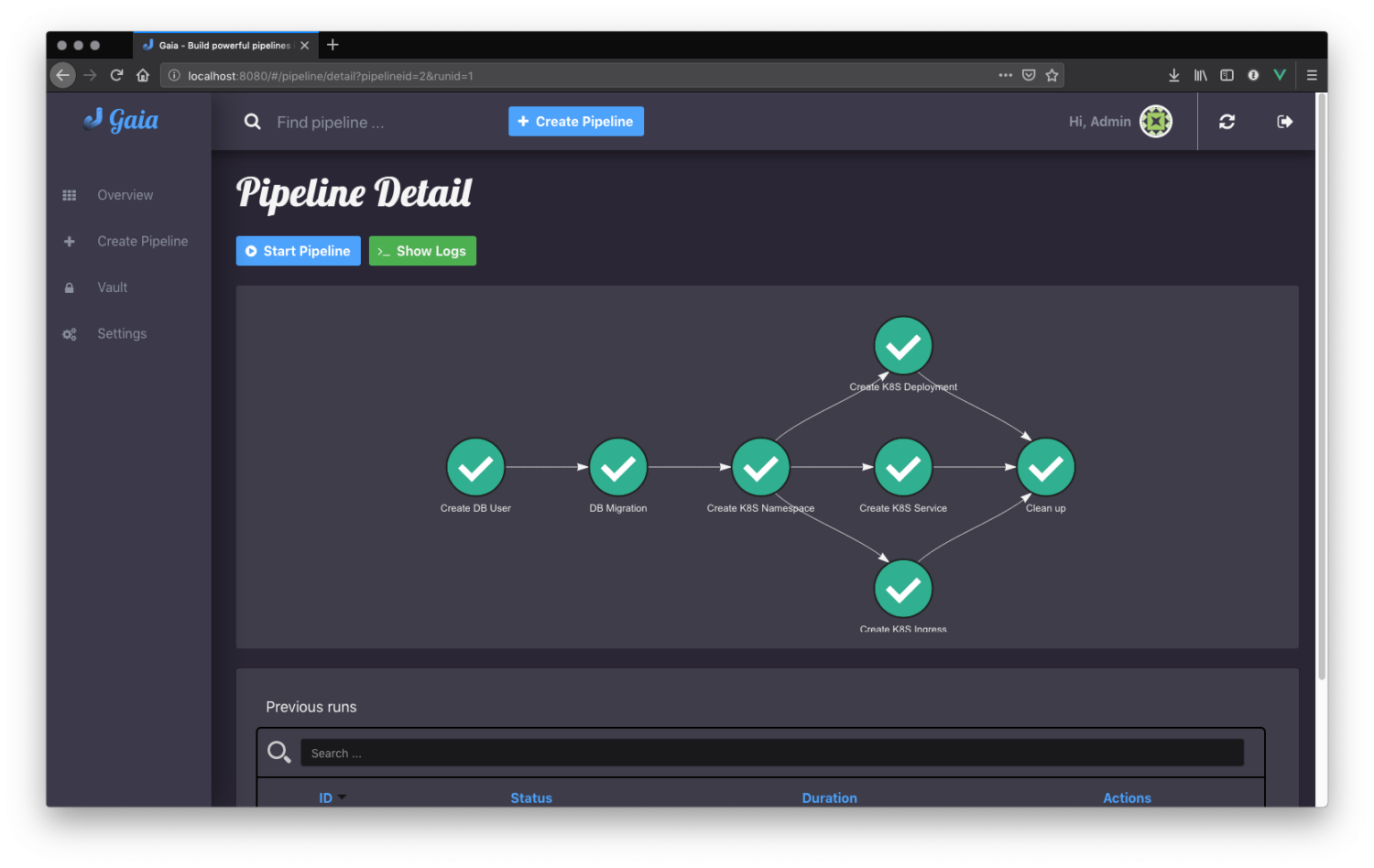
Key Features
- Enables teams to develop reliable development pipelines.
- Enables developers to automatically clone, compile and execute code on demand while providing all the results in a user-friendly format.
- Gaia can clone the git repository and build the associated development pipeline. And once there are changes in the Git repository, the platform rebuilds the pipeline automatically to incorporate the changes.
- Gaia Integrates with popular tools such as Docker, Kubernetes, Python, Java, GitHub, Git, and more.
- The developer-friendly tool allows teams to build automation workflows or pipelines using their preferred programming languages. Supported languages include Python, Go, Node.js, C++, Java, and Ruby.
The platform, whose core is based on HashiCorp Go and its pipeline communication on gRPC, is lightweight, super fast, and efficient.
Devtron

Devtron is a powerful delivery platform that unifies and enhances reliable open-source software development tools into a single solution.
Key Features
- Supports a wide range of CI/CD, DevSecOps, GitOps, Observability, and more.
- Integrates seamlessly with popular products and tools across the software development lifecycle. This includes popular cloud platforms, tools in the CI/CD pipelines, test automation, monitoring, security, notifications, build automation, and more.
- It uses a single pane of glass to show teams the impact of the code in the clusters.
- It is a cost-effective platform that uses autoscaling and cloud resource scheduling to ensure organizations only pay for what they use. It adjusts the resources based on demand, preventing organizations from paying for what they are not using.
- It also has a dashboard to provide visibility into resource utilization.
It uses automation to minimize manual processes and errors, enabling organizations to build, test, deploy, and deliver software products much faster.
Meshery
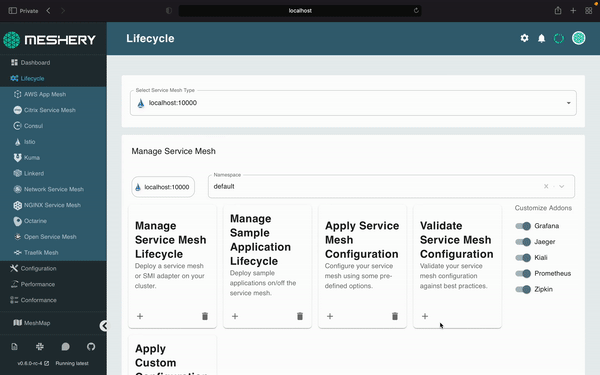
Meshery is a customizable Kubernetes manager that allows you to confidently take care of your cloud infrastructure.
Key Features
- Integrates seamlessly with Kubernetes clusters and your existing tools. This allows you to customize and improve your CI/CD, monitoring, and security solutions.
- Automates provisioning of service meshes while enabling users to choose different configuration profiles that support their specific deployment models
- Provides actionable reports while highlighting those to prioritize or require immediate action.
- Its Kubernetes-native approach enables organizations to easily incorporate the tools into existing workflows with little effort and without additional setup.
- Meshery offers configuration, lifecycle, and performance management of service meshes and workloads.
The extensible tool supports over 220 integrations and add-ons to ensure you have all you need to manage a cloud-native infrastructure.
Terraform
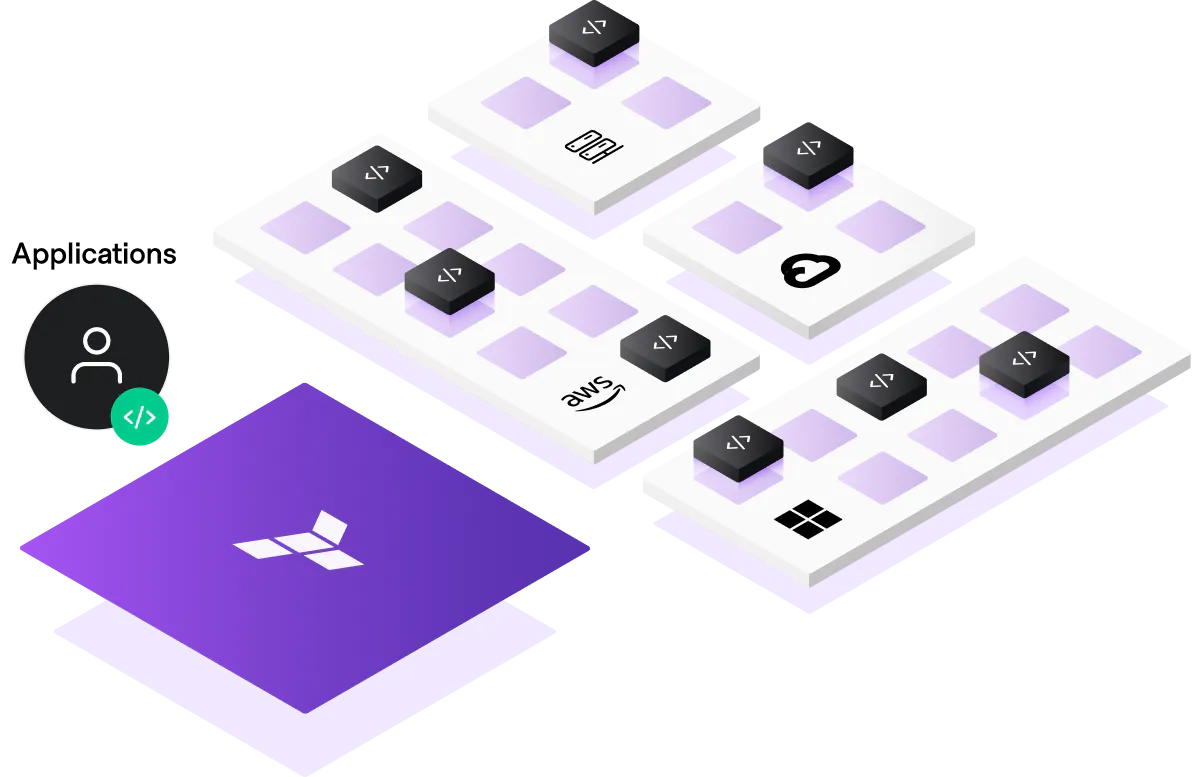
Terraform is a popular infrastructure automation tool. It enables organizations to automatically provision and manage a wide range of resources in any type of cloud or data center. The platform allows teams to deliver the cloud as code.
Key Features
- Enable teams to provision and manage infrastructure across multiple clouds consistently. This increases the fault tolerance of the development infrastructure, thus, enabling faster recovery when one cloud service fails.
- Enables teams to securely and effectively create, modify, version, and manage on-premise and cloud resources.
- Supports collaboration between teams using policy enforcement and role-based controls.
- Enhances security using role-based access control that enables administrators to define and manage user permissions hence controlling how users access the infrastructure resources.
- Integrates with CI/CD pipelines, hence streamlining the process of streamlining the infrastructure provisioning
- Provides automated configuration drift detection and management in the infrastructure deployment.
By codifying and automating the infrastructure provisioning, terraform accelerates cloud adoption while eliminating the inefficient, slow, and cumbersome manual provisioning of resources.
Sonatype

Sonatype is one of the top full-spectrum software supply chain management platforms that enable organizations to streamline processes and manage their development environments.
Key Features
- It gives software developers total control of their cloud development environment, including source code, third-party open-source code, containerized code, and software as code.
- Provides deeper insights such as migration scorecards, anomalies, nudges, stack divergence, and more, enabling teams to make data-driven decisions.
- Automated policy enforcement
- Provides high scalability and availability
- It enables organizations to build more reliable, secure, and maintainable software products.
The developer-friendly platform empowers teams with intelligent solutions and tools to securely operate, manage and scale the entire software supply chain. Empower teams to code faster, securely, and smarter.
Fleet

Fleet is a lightweight open-source device management tool for GitOps, YAML, APIs, webhooks, and other software production systems.
Key Features
- Automating the management of multiple production devices while providing enhanced control, visibility, and stability.
- Enables teams to automate the deployment of the configurations and other functions using GitOps.
- Excellent vulnerability management to ensure the security of the applications. It checks and reports on security vulnerabilities, non-compliance, and exposures in your development environment by monitoring the operating systems, software packages, browsers, and other assets on your production computers and systems.
- Coexists well with other security tools and agent-based vulnerability scanners such as Rapid7, Crowdstrike, and SentinelOne.
- Integrates well with tools such as Puppet, Munki, Ansible Chef, and more.
It helps to automate the device management and configuration deployment while providing enhanced control, visibility, and stability.
Plural
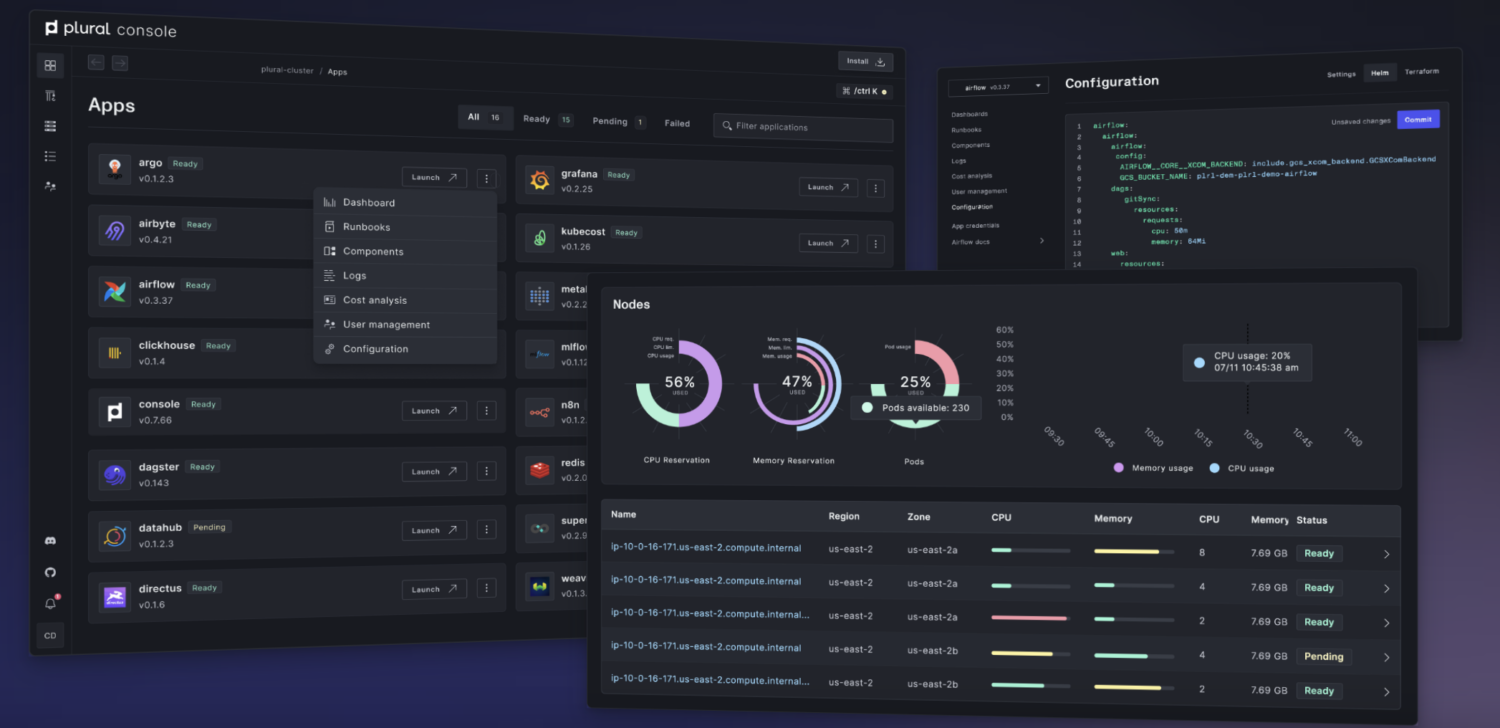
Plural is an open-source application deployment platform that enables teams to deploy Jitsu and others on Kubernetes.
Key Features
- Provides enhanced security by default. The tool often scans the application images, Terraform modules, and help charts to ensure the security of the applications and platform. Additionally, it uses OpenID Connect to securely authenticate users for the Plural deployed applications.
- Uses dependency-aware deployments and upgrades to manage the dependencies between the Terraform and Helm modules.
- Handles issuing security certificates and DNS configurations while enabling zero-touch login security.
- Easy to set up in only a few minutes using either cloud shell or CLI. It also provides more than 90 open-source production-grade applications that you can easily deploy in your production environment.
- It enables you to build and deploy applications securely using security-scanned and hardened images. Also, it uses centralized user management, strong authentication, and granular Role Based Access Control.
It makes applications portable, and you can use it to deploy applications on any cloud.
Final Words
GitOps provides organizations with the tools and practices to better manage infrastructure and application deployments.
By combining GitOps and Kubernetes or other platforms, software companies can enjoy benefits such as improved performance, flexibility, scalability, efficiency, faster delivery of application features, and more.
Next, check out the article on GitOps vs DevOps.




